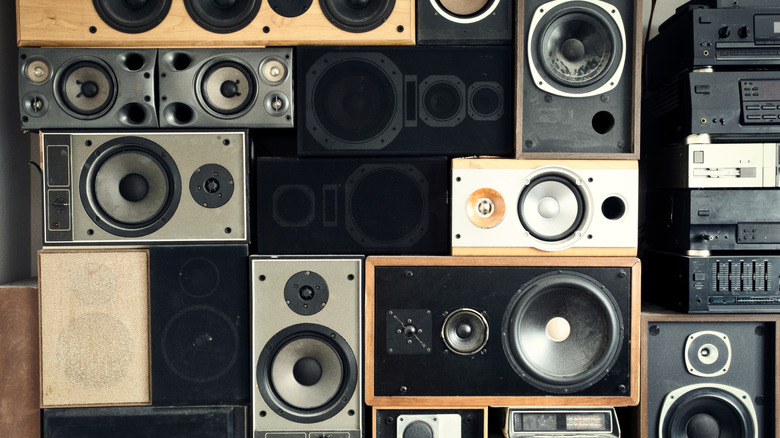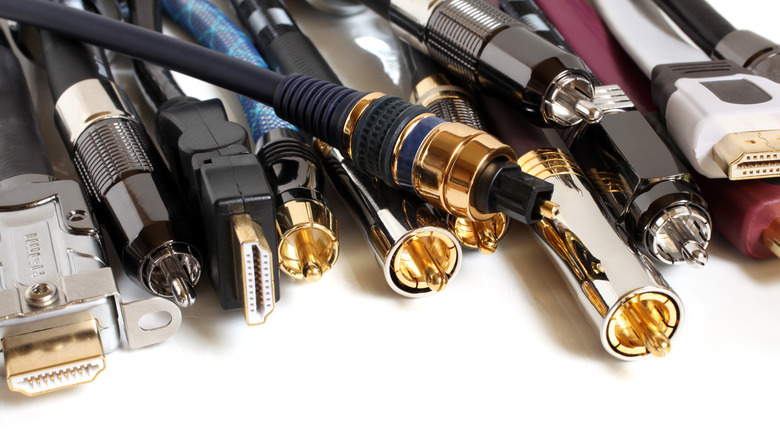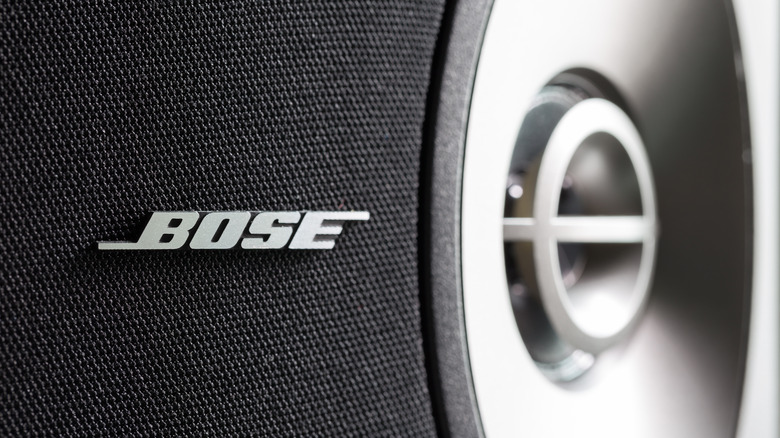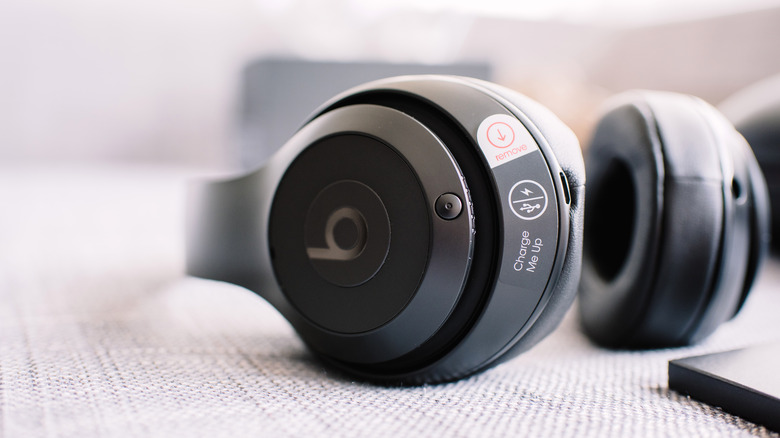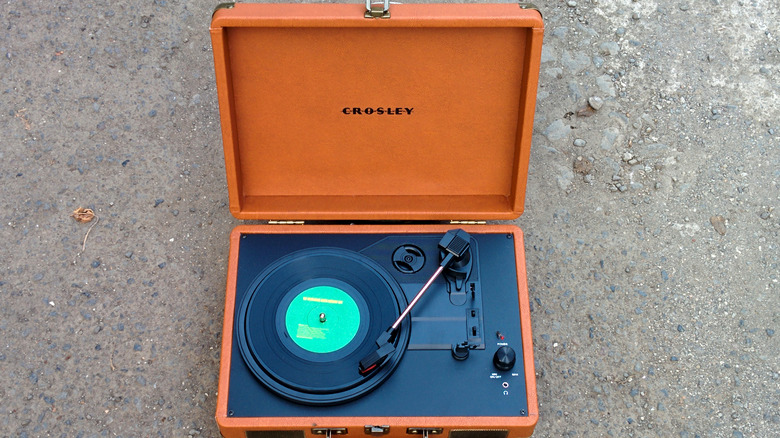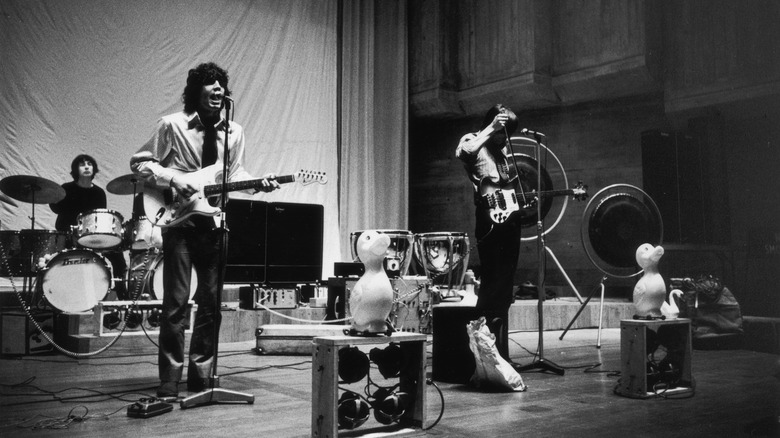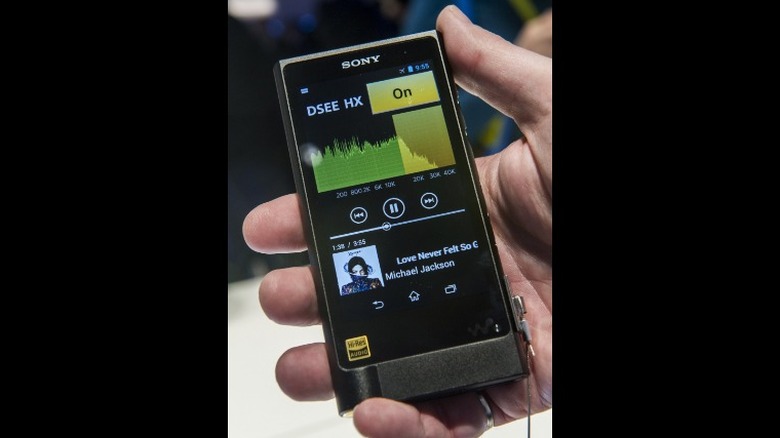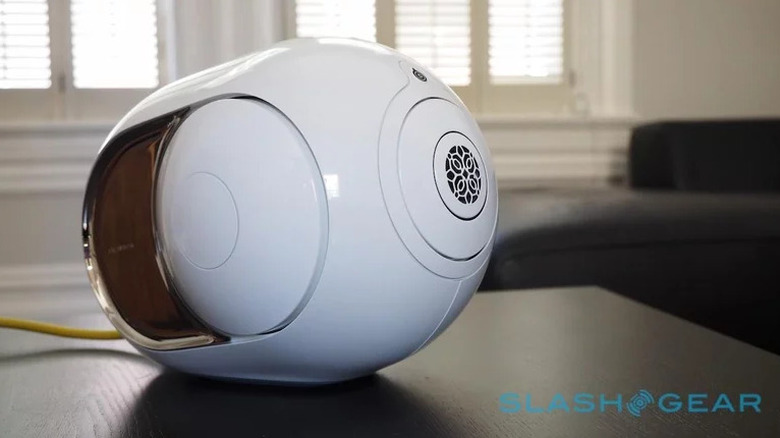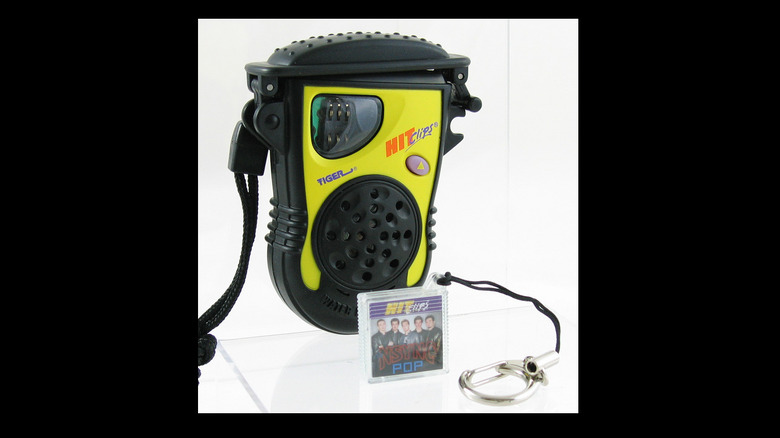Audio Tech That Is A Total Waste Of Money
The modern world has blessed us with myriad technological innovations to make life not just more pleasant, but more entertaining. The industrial revolution brought on changes that reduced our workload and increased production such that food could be more plentiful and travel less arduous. As the computer age dawned, we also found ways of applying technology toward pastimes and leisurely pursuits, such as the enjoyment of music.
From the early days of the phonograph and the AM radio, technology has come a long, long way. We now have all manner of wireless transmitters and receivers, broadcasts in high definition audio, and media players the size of a credit card. We are spoiled with choices of products on which spend extravagant amounts of money. High-quality equipment can demand a premium price — and is often worth it. Live performances demand a higher caliber of audio technology. Living rooms, though, may not. Some products promise sound quality so high that it can be detected by almost nobody, save for the most pitch-appreciating among us. It's easy to waste money on audio tech, and these ten items are proof.
Donda Stem player
Talking about Kanye West anymore is fraught with possibilities of awkward reactions. He has taken his life in an interesting direction, from his sudden embracement of faith to his harassment of Pete Davidson in connection to his ex-wife. All controversy aside, West has built a successful career making highly popular music, although some critics might say his prime is passed. Still, he continues to work and his latest musical release — Donda — arrived most unusually.
The Donda Stem Player is a fascinating concept where it is difficult to tell whether it is a genius piece of kit or a terrible foray into useless hardware. The player is similar in shape and size to a hockey puck. Its only interface is four bars of colored LED lights and a central button. It allows the user to mix tracks of the individual songs from the album and play around with the final mix using each string of LEDs as volume sliders. It is novel and even clever, but also a bit useless. The device can be loaded up with other music, although, according to Engadget, the track mixing isn't quite so clever on non-Kanye music. And it has no screen to tell you what you are doing. It is a novelty for $200 and, especially at that price, it is quite a rip-off. Maybe he will do better to impress with his upcoming Donda foam car.
High priced cables
One mistake that can be made by a first-timer putting together a nice audio system is to invest in quality equipment and then cheap out on the hardware needed to connect it all together. It makes sense when spending top dollar on amps, turntables, and tuners to make sure the cables and wiring that go between them are also high quality, but there is a limit to how much difference the type of cable actually makes.
Is there a genuine discernable difference between the fidelity of a $50 stereo RCA cable and one that costs four times that? What actually matters is that no matter what quality wiring you choose, it is appropriate for the application. Once you have the gear set up with the correct specifications, experts will tell you there is not much reason to buy the more expensive cables and wires (via Gear Patrol). As long as they function correctly, the difference in sound quality is negligible. You are welcome to spend your cash on $40,000 cables, but it would probably be a far wiser decision to save that money for more electronic toys.
Bose audio systems
Bose is an innovative company with a long history of engineering novel solutions to age-old problems with sound reproduction. The company has pioneered the art of producing big sounds from small packages, and has even developed a trick magnetic suspension system slated to go on cars soon if some haven't been produced already. So the company has no shortage of ideas and know-how, but some people, especially audiophiles, still feel Bose is not really up to snuff compared to its competition.
There are several reasons that the real audiophiles shun Bose, according to Geek Musician. Part of this shunning has to do with how Bose achieves fidelity in sound reproduction. The company has worked for a long time to recreate sound with high clarity and dynamics through tweaks in software and sound processing rather than beefing up analog components or other analogous methods. They also complain that some of the materials are subpar, and this could be a result of more of its efforts going into the processing. Bose does not release comprehensive details of the manufacturing and some consumers feel this practice may be hiding something.
The arguments for and against Bose fall into the subjective rather heavily. The reality, though, is that plenty of superior products exist (JBL, for example) — even though more inferior products crowd the shelves in the stores.
Beats by Dre
If you want to quickly get into a heated argument, tell someone their $300 Beats by Dre headphones are crap. It may not be wise, but you also may not be wrong, even if calling them crap is a bit hyperbolic. The truth is that Beats benefits from a substantial marketing budget, one big enough to make a product a best-seller without the quality to back up its popularity.
Stop random people on the street, especially younger ones, and ask them if they have ever heard of Beats headphones, you will likely encounter affirmative answers. This is no fluke, as Beats spends a huge amount on advertising and works particularly hard to get celebrity endorsements and product placements. BGR says this is a substantial reason why they are not worth the price. With similar headphones from a company like Audio-Technica, you get better sound from a lower price point because it puts more budget into the manufacture and development instead of marketing. That means you are paying for the label.
Beats look cool and may give you a bit of street cred. They are decent products and our many reviews have ended with positive impressions of Beats products, but it is fitting in a SlashGear review, the market segment listed for the headphones was the "fashion headphone" market. For true music lovers, fashion is secondary to sound quality. Headphones are a tool for reproducing sound, not just a pretty accessory.
Crosley turntables
The Crosley name has been affixed to radios and other products, including automobiles, since the early 20th century. The online Radio Museum states that Crosley Radio Corporation manufactured radios through the "Golden Age of Radio" from 1921 until 1956. Although Crosley quit the radio business in the '50s, the name lives on today. The Crosley brand was resurrected in the '90s to build modern retro-styled electronics.
The modern Crosley brand is a far cry from the original American-made products. For decades, American manufacturing has been synonymous with quality. Today, some of the cheapest Chinese-made turntables on the market bear the once proud Crosley name. The New York Times reviewed a modern Crowley plater and discovered almost zero redeeming qualities. The playback is tinny and almost completely devoid of bass tones whatsoever, it found. Furthermore, the weight of the stylus is sure to wear out the record, as there seems to be almost nothing to balance the tonearm and relieve its pressure on the platter. The sound reproduction was terrible on the tiny onboard speaker, but even when plugged into an external amp, distortion ruled the day and was accompanied by noise from the motor turning the record itself.
Not everyone wants to spend a month's wages on a turntable, and that is fine. It's just that it would be better not to buy the Crosley at all and hold out for a slightly more expensive model, as the Crosley will only disappoint your ears and ruin your records.
Quadrophonic sound
Innovation is a peculiar thing. Inventors and engineers strive to create the next big thing, working to improve and outperform last year's top products. Consumers' tastes can be fickle, and that means the next best product may not be the next most popular product. This seems to have been the case for Quadrophonic sound, something we might call surround sound these days.
Ever since stereo sound was introduced in the late '50s, engineers looked for ways they can improve the listening experience. At some point, the hi-fi came along with separate speakers for producing high and low sounds with later efforts adding rear speakers to the mix. This technology came from several companies adopting differing monikers, such as Quadriphonic, Quadrophonic, Quadrisonic, Quadrasonic, and Tetrasonic.
Several problems led to the demise of Quad sound. The Guardian's Martin Belam discusses this in detail on his personal blog and puts its demise mostly on the expensive equipment needed to play it. Once someone did shell out for a new system, they'd discover that few artists produced quad records because of low demand, although Pink Floyd was an enthusiastic early adopter. The lack of a single standard among manufacturers further led to consumers opting for more affordable technology that they were already familiar with. Today, these systems may be valuable due to their rarity, but when they were new, it was mostly just a status symbol.
Pono Player
Ever since the first sound was recorded onto a wax tube, people have been trying to increase the quality of audio reproduction from various mediums. Degradation of audio is always a concern, and that is why so much effort has been made to get higher fidelity with new technology. While the mp3 helped to usher in the digital age, the file format was created to make files small for easy storage and transfer. In making digital files compact, audio quality is compromised. It seems the loss of quality spurred legendary Canadian rocker Neil Young to act.
In 2015, Young launched an all-new audio player called Pono with an accompanying music download service that promised a music listening experience with audio quality surpassing every other digital format available, including a compact disc. SlashGear reviewed the Pono and came away with a generally positive impression of it. The triangular shape seemed odd at first but proved to make it feel natural and comfortable when holding it. The quality of the music is extraordinarily good when paired with high-end headphones. Pono delivered what was promised.
There was nothing wrong with the product. It was well-built and well-executed, but consumers did not buy into the concept. While some people can be quite fussy about their music, most people don't care as long as it is not awful — and that made the Pono just too much money for broad acceptance by consumers.
Sony NW-ZX2
Sony pioneered the portable music market when it introduced the Walkman in 1979. The device has a fascinating history and was a runaway success from the start. The digital age and the introduction of the iPod disrupted Sony's hold on the market, however, and new digital iterations of the Walkman have struggled to dominate in the same way as the original. But Sony, being an innovative company, never gave up.
Enter the Sony NW-ZX2, a Walkman for the modern age. We reported that the 2015 Walkman showed up with an Android interface and the ability to reproduce music in Hi-Res Audio, also known as Free Lossless Audio Codec, or FLAC, as well as compressed formats such as mp3. It would play music files through advanced digital processing with equalization to optimize the audio for the best possible listening experience. What Hi-Fi noted that the ZX2 is built of extremely high quality and its looks as though it is comparable to old Sony cameras that are built like precision tanks, lined with textured leather, and have a heft to them that signifies quality. However, for all of this, one must let go of upwards of $1,000. Again, some people are more than willing to pay to get that top-quality listening experience, but spending a grand may be a bit too much for the average consumer.
Devialet Phantom I
It is often said that one should not judge a book by its cover, which may be good advice upon viewing the Devialet Phantom I. It is an odd-looking contraption that purports to be among the best portable speakers on the market. It may be, but it also commands a premium. At $2,200, you should expect it to deliver an above-average listening experience. But still, at that price, is it worth it?
SlashGear reviewed one back in 2016. Its appearance is the first thing one notices, as its strange design is too obvious to ignore. But how it functions is ultimately more important. The reviewer compared it to the excellent and more affordable Sonos PLAYBAR only to discover that the Phantom really does deliver a richness of sound and clarity not found on the other device while providing excellent bass — even despite its lack of a subwoofer. In short, it is an excellent product although it is not without flaws. However, for $2,200, is it that much better? There are dozens of ways to spend a couple of grand on stereo equipment and come out with fantastic sound. Perhaps this will be a cute oddity in the living room of the eccentric doctor or lawyer, but, for most of us, it sure looks like a good way to waste a bunch of money.
Hit Clips
Audio tech need not be expensive to be a waste of money, as evidenced by Hit Clips. Coming out just in time for the new millennium, Hit Clips sought to piggyback on the success of then-new mp3 players by marketing similar devices to kids. The Museum of Obsolete Media noted that they were produced by Tiger Electronics from 1999 to 2003 and consisted of a small media player that played proprietary solid state discs, or "Clips," exclusively. Only about 50 tracks became available from the likes of Britney Spears, NSYNC, and Pink, however, the songs were truncated to just one minute in length.
The idea for Hit Clips was novel and saw some success. Kids often want to have the technology they see adults using, so Tiger gave them an affordable and durable alternative. At just $20 for the player and $4 for the clips, parents would not be overly worried about losing money should they get lost or broken. Mashable argued that this was a fairly ingenious ploy by Tiger, since a one-minute Clip, priced at $4, was far more expensive than buying a full album for around $15. But it was trendy and the new thing and Tiger made a bunch of money selling them.
Hit Clips only lasted a few years and they were, from the start, a total waste of money. That said, most parents know that if it makes the kids happy, it doesn't really matter.
